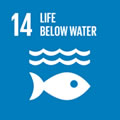Por favor, use este identificador para citar o enlazar a este item:
http://hdl.handle.net/10261/354038COMPARTIR / EXPORTAR:
 SHARE
BASE SHARE
BASE
|
|
| Visualizar otros formatos: MARC | Dublin Core | RDF | ORE | MODS | METS | DIDL | DATACITE | |

| Título: | Major contribution of large marine phytoplankton to osmotrophic amino acid assimilation in a natural community |
Autor: | Mena Oliver, Catalina; Forn, Irene CSIC ORCID ; Dordal Soriano, Júlia; Samos, Iván P.; Sebastián, Marta CSIC ORCID; Deulofeu, Ona CSIC ORCID; Massana, Ramon CSIC ORCID ; Gasol, Josep M. CSIC ORCID ; Ruiz-González, Clara CSIC ORCID | Fecha de publicación: | 6-jun-2023 | Editor: | Association for the Sciences of Limnology and Oceanography | Citación: | ASLO Aquatic Sciences Meeting (2023) | Resumen: | The osmotrophic uptake of dissolved organic compounds in the ocean is considered to be dominated by heterotrophic prokaryotes, whereas the role of microbial eukaryotes is still unclear. We explored the capacity of a natural eukaryotic community to incorporate a synthetic amino acid (HPG, analogue of methionine) using biorthogonal noncanonical amino acid tagging (BONCAT) and compared it with that of prokaryotes throughout a 9-day survey in the NW Mediterranean. We found a large diversity of autotrophic and heterotrophic eukaryotic cells incorporating HPG into proteins, with dinoflagellates and diatoms showing the highest percentages of BONCAT-labelled cells (50 ± 20%, mean ± SD). Among them, pennate diatoms exhibited a clear diel pattern of osmotrophic activity, with higher activity in the afternoon than in the morning. On the contrary, small eukaryotes (<5 µm) showed higher activity in the morning than in the afternoon, and the percentage of active cells was lower for phototrophs (0.6-7%) than for heterotrophs (13-17%). Centric diatoms dominated the eukaryotic HPG incorporation due to their high abundance and large sizes, accountig for up to 86% of the eukaryotic BONCAT signal. When comparing to the prokaryotic HPG incorporation, we estimated that the whole eukaryotic community accounted for 19-31% of total BONCAT signal. Together, these results suggest that osmotrophy may be relevant to eukaryote nutrition, especially for large phytoplankton, and highlight the significant role eukaryotes could play in the consumption of dissolved organic matter in marine systems | Descripción: | ASLO Aquatic Sciences Meeting, Resilience and Recovery in Aquatic Systems, 4-9 June 2023, Palma de Mallorca, Spain | URI: | http://hdl.handle.net/10261/354038 |
| Aparece en las colecciones: | (ICM) Comunicaciones congresos |
Mostrar el registro completo
CORE Recommender
NOTA: Los ítems de Digital.CSIC están protegidos por copyright, con todos los derechos reservados, a menos que se indique lo contrario.


